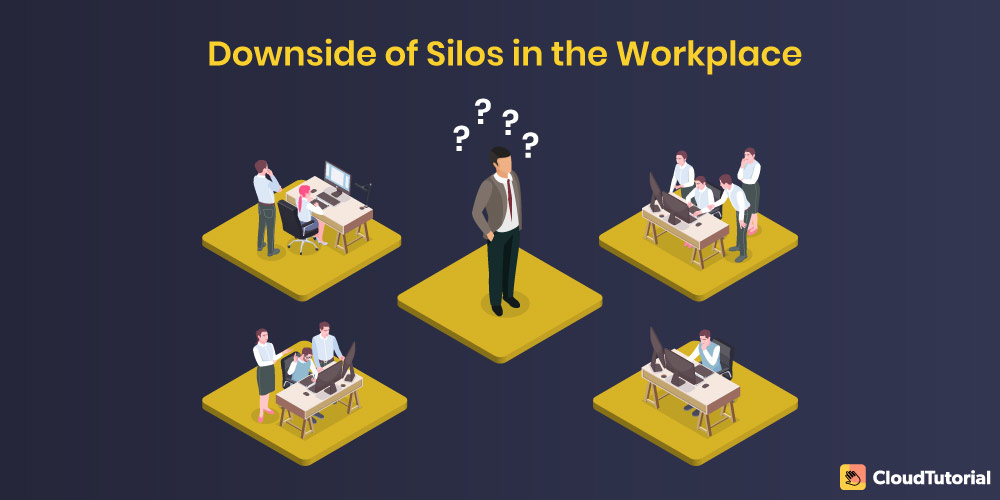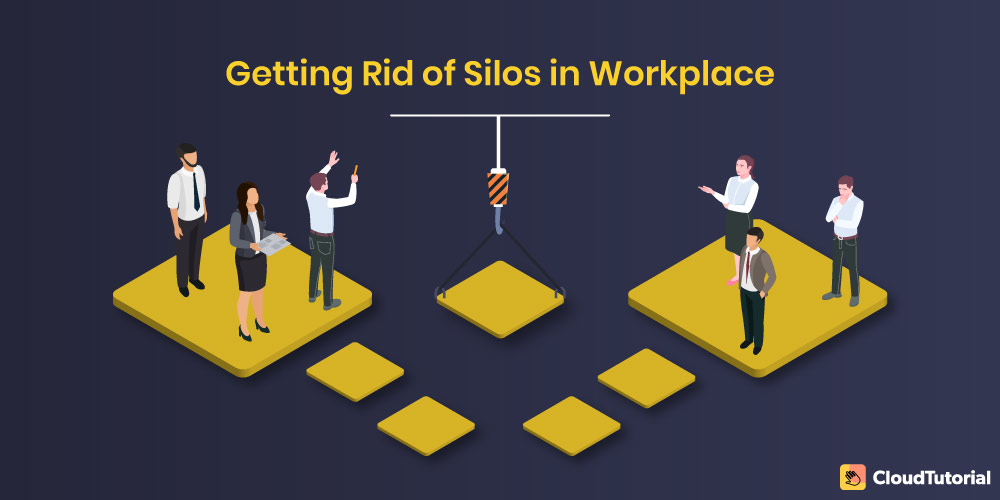Why are businesses unable to eliminate barriers that prevent collaboration and communication across different departments? It’s because of silos in the workplace.
The silo mentality is where employees do not share information across departments in the same organization. It is an attitude that will kill productivity by reducing the overall efficiency in operation, reduces trust, and morale among the teams.
Fortune 500 companies lose approximately $31.5 billion every year due to ineffective knowledge sharing across teams. Only 25 percent of senior executives admit that their organization is effective in knowledge sharing, while the rest of 75 percent are taking financial losses.
Silos are the reason behind department inefficiencies. They are a significant challenge for executive leaders to establish a proper vision and mind-set to eliminate these cross-departmental barriers.
Table of Content
What are Silos in the Workplace?
Workplace silos occur when information doesn’t get shared across different departments and teams. It results in incorrect priorities.
What if the marketing department decides that the product should target HR professionals, and on the other hand, the sales team thinks the product should target C-suite executives?
This miscommunication leads to a lack of trust between team members. Teams may start hiding information from each other, which will lead to a lack of knowledge that could help others across different departments.
It will affect not only operational efficiency but also overall employee engagement. All this leads to a poor customer experience.
But, what causes silos in organizations?
-
Lack of Team Mentality
Workplace silos occur when a group focuses more on their department objectives instead of the company’s goals. It’s due to a lack of understanding as to how they fit into the bigger picture.
What will happen to a sports team if players focus more on personal statistics than their team winning or losing? In sports, if team members don’t get focused on winning the game, they won’t do well even if there is an exceptional player on the team.
The same applies to businesses. Silos get created when different departments stop focusing on the overall goal of being successful in the market. It’s the fault of leaders.
-
Competing for Resources
Workplace silos also exist due to competition between departments for resources. It becomes competitive because executives focus on the needs of their department rather than the company. These typically occur during the budget cycle or when there is a discussion about additional headcount.
-
Lack of Communication
Lack of communication is one of the prime reasons for organizational silos. It starts with the leaders. Most of the issues occur because of a lack of communication between different departments. Each sets their directions and priorities without knowing or caring for others and their needs.
-
Misguided Incentives
Misguided incentives also lead to workplace silos. The way different departments get incentivized can create problems for a company.
What if sales incentives get based on signed contracts regardless of what it contains?
You will end up with non-performing contracts. Misguided incentives can hurt an organization in the long run.
-
Losing Focus on Company Goals
Groups often focus on immediate results rather than company goals. It leads to silos in the workplace.
What if the engineering team removes an essential feature to release it before the deadline? It will make them look good, but the overall quality of the product will suffer.
What if the sales team only focuses more on getting signed deals? There is a high chance that those deals are not beneficial for the company.
The overall goals of a company should be clear at every level. If not, the teams are left to create their objectives, which may not sync with other departments or the company goal.
Build an advanced knowledge base for your customers and give them answers fast – real fast.
Take your app and help center to the next level with CloudTutorial.
Some Examples Where Silos Have a Positive Effect
Can silos ever be a good thing? Well, sometimes organizations can reap good benefits.
-
Expert Nurturing
Silos can help employees stay focused on their areas of expertise. Hence, their expertise will improve over time, and they will become industry experts. It will create subject experts for every field of the business.
-
Client Specialization
Silos are useful when you want a section of your employees to focus on one particular client or project to provide the best client experience, services, or products.
-
Collaboration Control
Communication is an effective way of dealing with organizational silos. But, too much of it can also be problematic. There is a difference between decision making and execution.
Cross-departmental collaboration is useful for making the right decisions, but once it gets made, too much of it during execution can bog it down.
Important decisions should not get made in silos, but the execution should not get held up by other departments.
-
Chinese Walls
The Chinese wall is similar to silos. It’s a practice of companies siloing teams to keep the internal-news and secrets of their clients safe. The purpose is to avoid conflict of interest. It’s a concept where a business serves two different brands that are competitive with each other.
It removes any potential conflict as two separate teams work for the brands and don’t share any information. Both teams have different offices to create a physical barrier.
Silos can be beneficial, but there has to be a balance. Finding the right one is essential but not easy.
Silos in the Workplace: The Downside

-
Unhealthy Relationships Between Teams
Silo mentality can lead to bad relationships between different teams. There may be a lack of trust between the management team due to different agendas or personality differences, and it may lead to them focusing more on their success. They won’t care about the organization’s success.
-
Teams Lose Sight of Company Goals
Silos occur when teams have different priorities and don’t focus on the overall goals of the business. A business consists of marketing, sales, engineering, and customer support, and each has its objectives and goals.
What if there is a lack of communication between these departments due to silos? Or what if the silos are causing them to compete for resources?
All this will only create animosity between these departments and affect the business’s overall goals.
-
Disruption in Communications
Disruption in communications may cause the marketing team to conflict with the engineering team because they don’t know about the new product release or its features.
Engineering may get in conflict with the sales team because they advertise the features that don’t exist in the product.
Customer support has to solve the issues that customers experience in the product. It may strain their relationship with the engineering team due to defects in the product. They may even not share the data on how the customers are using the product with the engineers.
These are just examples of how silos can disrupt the communications between different teams and strain their relations. It is not a good situation for any business.
Build an advanced knowledge base for your customers and give them answers fast – real fast.
Take your app and help center to the next level with CloudTutorial.
How to Get Rid of Silos in the Workplace?

Eliminating the silo mentality will improve your company culture and processes. Here are some suggestions for the teams:
- Encourage more collaboration: The teams should conduct more meetings to discuss projects.
- Develop a free internal knowledge base: The teams should have a go-to place to access all types of information.
- Encourage teamwork: Teams perform better when their members have strong connections with each other. Offer mentor programs and leadership boards to set standards for performance.
- Communicate frequently: Instead of occasional calls, have an open stream of communication. Provide an instant messaging app or channels for your team.
- Resolve workplace friction: The team should have a complete understanding of workplace tools. Don’t try to push them into using software they don’t want to use and provide full access to the systems that your team may need.
- Use collaboration tools and work towards common goals
- Communicate frequently
- Assess compensation plans
- Implement collaboration software
- Train, work, educate together
Connecting with information in a free-flow will benefit the business operations. What if a retailer freely shares the data on customer service interactions, inventory, internal costs, and shipping? Well, so many potential problems can get avoided, and organizations can improve their customer service.
To break down silos, you need to develop a unified vision and have a common goal. The leadership team needs to evaluate compensation plans, implement a CRM, and conduct cross-departmental training.
Try it out before you decide.
Create a test article NOW!
Using this tool, all you have to do is add your first test article and see how it looks. Now, you don’t have to sign-up or login into CloudTutorial software just to check how your first article appears.

